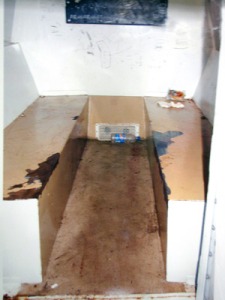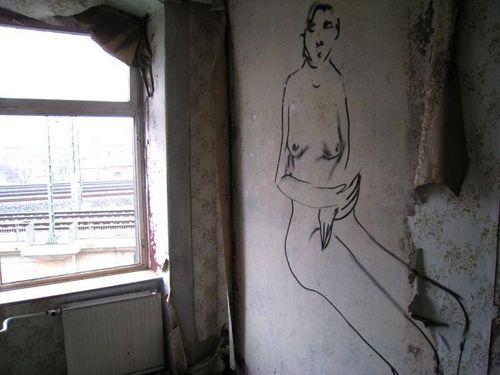
Certainly very appealing 🙂 . Federico Solmi‘s crucifix related to his 2008 hand-drawn animation video, “The Evil Empire”, according to jameswagner.com a satirical look at the outrageous exploits of a fictive pope, and a part of his “ongoing desire to satirize tyrants”. The crucifix caused a bit of furor while recently being shown at Bologna’s Arte Fiera. One could guess that it was the prominent red and white sub-object that aroused local judge Bruno Giangiacomo – even though he apparently had only heard about it second hand. He sent in the equally local Carabinieri who seized the crucifix from its display booth and charged the arist with blasphemy and obscenity. Problem though was that it had already been sold to a collector and that the statute had been allowing the blasphemy charge had been rendered null by a constitutional court in 2000 – the judge hadn’t kept up his frequent reading of legal literature one could guess. So the whole thing was a bit of a storm in a teacup, although it might have been a good marketing campaign for Solmi, as these backfiring conservative censorship attempts often are (not sure what happened to the obscenity charge).
Interesting that the whole event took place in Bologna, which always was a centre of the political left. jameswagner pointed out that the city “has the reputation here of being Italy’s most politically and socially radical. The artist’s own home town and the capital of Emilia-Romagna, Bologna led the country’s socialist movement early in the twentieth century, was extremely active in the revolt against the fascists in 1944, and after the war, until the last decade, the city consistently voted for communist governments”. But then, the socialists probably have become social democrats and the communists socialists; therefore with the whole spectrum maybe having moved to the right, conservative attacks on artistic freedom might not be unusual anymore. And: Italy for a long time now has always had strong politcal extremes.







![Reblog this post [with Zemanta]](https://i0.wp.com/img.zemanta.com/reblog_e.png)



 The health community is up in arms over the discovery that a highly-respected and influential clinical researcher, Dr. Scott Reuben, fabricated the data used in over twenty pharmaceutical studies published in peer-reviewed medical journals. Read the full NaturalNews report on this topic
The health community is up in arms over the discovery that a highly-respected and influential clinical researcher, Dr. Scott Reuben, fabricated the data used in over twenty pharmaceutical studies published in peer-reviewed medical journals. Read the full NaturalNews report on this topic  (
( State Coroner Alastair Hope heard Mr Ward died from heatstroke on the 42C day he was transported in the non-air-conditioned rear sealed compartment of a prison van for the 360km trip from Laverton to Kalgoorlie. The inquest was told Mr Ward had burns to his stomach and elbow, which were consistent with being in contact with a very hot surface. After being taken to Kalgoorlie Hospital he was put in an ice bath. His body temperature was 41.7C and he later died. The inquest, at Warburton, was told Mr Ward, 46, was given only a 600ml bottle of water and a pie for the four-hour journey.
State Coroner Alastair Hope heard Mr Ward died from heatstroke on the 42C day he was transported in the non-air-conditioned rear sealed compartment of a prison van for the 360km trip from Laverton to Kalgoorlie. The inquest was told Mr Ward had burns to his stomach and elbow, which were consistent with being in contact with a very hot surface. After being taken to Kalgoorlie Hospital he was put in an ice bath. His body temperature was 41.7C and he later died. The inquest, at Warburton, was told Mr Ward, 46, was given only a 600ml bottle of water and a pie for the four-hour journey. Most Jews I know get little pleasure from the existence of Israel; just the opposite. They feel disgusted by the behavior of their tribal kin toward Palestinians. This antipathy doesn’t concern Israel’s right to exist, a phony argument still maintained by hard line Zionists. Israel exists, period. Most of the world recognizes that. Anyone wanting to eliminate it belongs in the loony bin or prison.
Most Jews I know get little pleasure from the existence of Israel; just the opposite. They feel disgusted by the behavior of their tribal kin toward Palestinians. This antipathy doesn’t concern Israel’s right to exist, a phony argument still maintained by hard line Zionists. Israel exists, period. Most of the world recognizes that. Anyone wanting to eliminate it belongs in the loony bin or prison.
